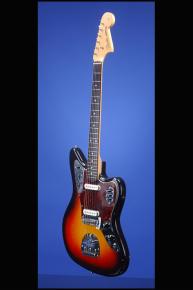One of The Very First Fender Jaguars… With a 'Slab' Rosewood Fretboard.
1962 Fender Jaguar.
This 13 3/4-inch-wide Jaguar weighs just 8.80 lbs. and has a "B" nut width of 1 5/8 inches and a scale length of 24 inches. Solid alder body, one-piece maple neck, and slab rosewood fretboard with 22 frets and inlaid clay dot position markers. Headstock with "Fender" logo in gold with black trim, "Jaguar" in black in bold letters beside it, and three patent numbers in black below. "Offset Contour Body" decal at the ball end of the headstock. Single "butterfly" string tree with nylon spacer. The neck is dated "1 APR 62B." Four-bolt neck plate with serial number ("74983") between the top two screws. Individual single-line Kluson Deluxe tuners with oval metal buttons (stamped "D-169400/PATENT NO." on the inside). Two white oblong Strat-like pickups with notched metal side plates and balanced outputs of 6.24k and 6.61k. The potentiometers are stamped "304 6145" and "304 6124" (Stackpole November and June 1961). Four-layer (tortoiseshell/white/black/white) plastic pickguard with ten screws. Two controls (one volume, one tone) and jack socket on lower metal plate adjoining pickguard on the treble side, circuit selector (rhythm/lead) slide switch and two roller controls (one volume, one tone) on upper metal plate adjoining pickguard on the bass side, and three pickup selector slide switches on metal plate inset into the pickguard on the treble side. Black plastic Jaguar knobs. Jazzmaster-type floating tremolo and bridge with adjustable mute. This wonderful totally original Jaguar is in exceptionally fine (9.00) condition with a small area of surface loss on the lower edge of the back and just a few small marks on the edges. Complete with its original tremolo arm and bridge cover. Housed in its Original Fender tan Tolex hardshell case with brown leather ends and dark orange plush lining (9.25). Complete with the following original 'case-candy' - original black leather guitar-strap; original 12 page "Fender Jaguar Instruction Manual"; original "Fender Fine Instruments" hang-tag with matching serial number; original "Tolex" case hang-tag; original Fender polishing cloth; original case-key in original envelope; original receipt for the guitar and case dated July 26th, 1962; and even an old box of Gibson hand-made strings…
"Not content with the relatively expensive Jazzmaster, Fender introduced a new top-of-the-line model in 1962: the Jaguar. [The pricelist offered a basic Sunburst Jaguar at $379.50; a similar Jazzmaster was $349.50]. Another offset-waist multi-control instrument, the Jag seemed an attractive proposition, but still failed to dent the supremacy of Fender's dynamic duo, the Tele and the Strat...The Jag used a similar offset-waist body shape to the earlier Jazzmaster, and also shared that guitar's separate bridge and vibrato unit, although the Jaguar had the addition of a spring-loaded string mute at the bridge. Fender rather optimistically believed that players would prefer a mechanical string mute to the natural edge-of-the-hand method. They did not. There were some notable differences between the Jaguar and Jazzmaster. Visually, the Jag had distinctive chromed control panels, and was the first Fender with 22 frets. Its 24" (610mm) scale-length ('faster, more comfortable') was shorter than the Fender standard of 25" (635mm) and closer to that of Gibson. It gave the Jag a different playing feel compared to other Fenders. The Jaguar had better pickups than the Jazzmaster. They looked much like Strat units but had metal shielding added at the base and sides, no doubt as a response to the criticisms of the Jazzmaster's tendency to noisiness. The Jag's electrics were yet more complex than the Jazzmaster's, using the same rhythm circuit but adding a trio of lead-circuit switches...The Jaguar was offered from the start in four different neck widths, one a size narrower and two wider than normal (coded A, B, C or D, from narrowest to widest, with 'normal' B the most common)" (Tony Bacon, 50 Years of Fender, p. 36).
In mid 1962 Fender introduced its most expensive "top-of-the-line" guitar called the Jaguar. The Jaguar’s pickups are more powerful and better shielded, which eliminated some of the hum problems associated with the Jazzmaster. The shorter (24 inch) scale was favored by some guitarists at that time, especially the surf music players. The Jaguar shared its unique rhythm circuit with the Jazzmaster. This allowed a pre-set tone for rhythm playing.








